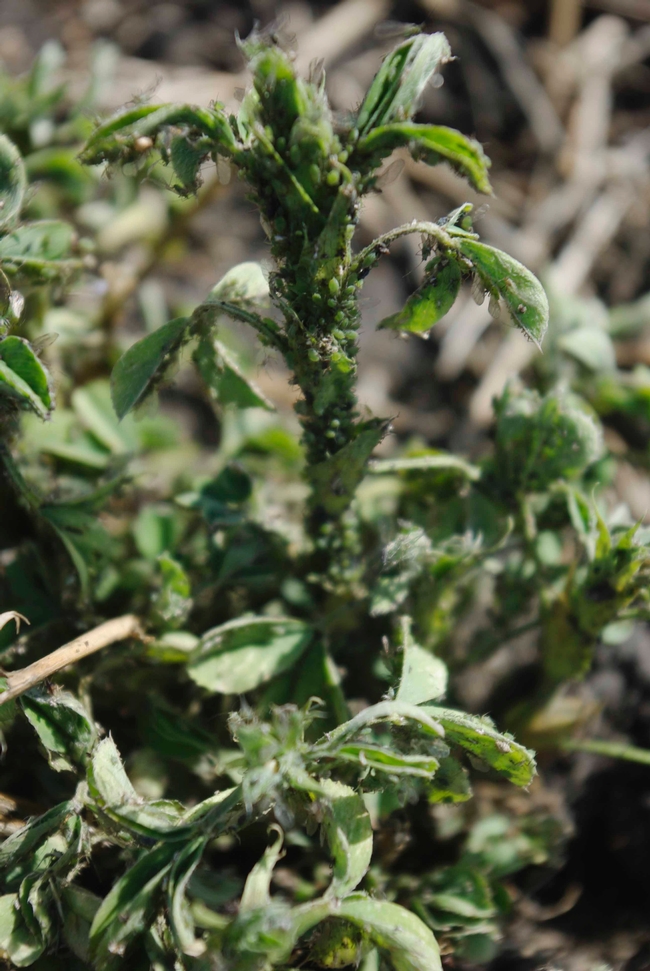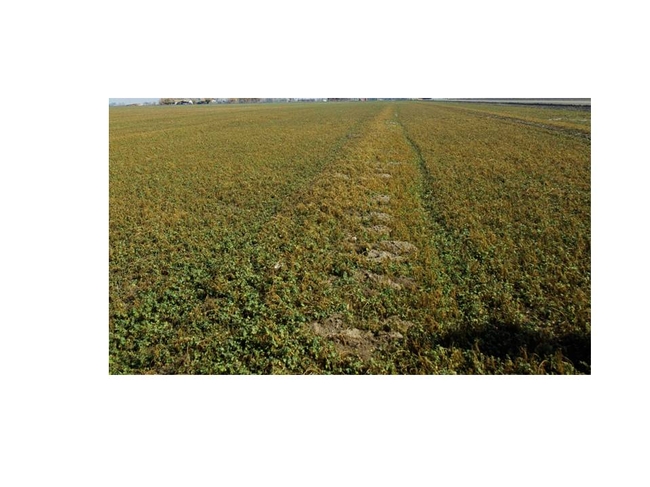Blue alfalfa aphid (BAA) populations have again been seen in southern and central California including locations in the Imperial, Palo Verde, Antelope, and San Joaquin Valleys (see Peter Goodell blog from 16 January 2014). In many locations, this was even an earlier build-up than observed in 2013. There are many theories and rumors as to what is causing this BAA population build-up. The “bottom-line” is that we do not know conclusively and research needs to be done to determine the reasons for this. The goal is to put together the resources (funding and personnel) to study this situation in a reasonable period of time. In the short-term, management practices will need to be developed to get through this situation until more permanent solutions can be found.
Management of BAA has always relied on a combination of tactics, i.e., solid Integrated Pest Management principles. Given the ability of aphids to quickly adapt to selection pressure, relying on only one management tool is risky and likely not sustainable. For this pest, three approaches are important.
1) Biological control including parasitoids, predators, and fungal diseases of aphids can provide good control.
2) Host plant resistance is another important management tool since many alfalfa varieties have been bred with resistance traits which reduce the ability of BAA to reproduce.
3) Insecticides are another useful tool and there are several insecticides registered for this pest.
The fourth component of BAA management is weather/environmental conditions that are conducive to BAA population growth and perhaps also inhibitory to the management provided by biological control, host plant resistance, and insecticide – a double whammy. “Mother Nature” is the overriding factor that influences alfalfa growth, populations of BAA, populations of the natural enemies, etc.
Biological systems such as insects in an alfalfa field are constantly changing. The insects adapt (evolve) to the adverse set of conditions they are facing including plant defenses, chemical insecticides, and predators and parasitoids. They do this in order to survive. BAA in alfalfa are no different and change is always occurring.
So what has changed over the last 2 years to result in the situation we are facing? Unfortunately, it could be any or all of the above factors.
1) Clearly the winter weather has been unusual the last 2 years and this could play a role. The biological control agents normally found in alfalfa fields could be changing. This could be induced by the weather conditions (for instance dry winters could result in lower levels of the aphid-killing fungus).
2) Loss of insecticide efficacy could be involved. Aphids clearly have the ability to develop insecticide resistance and the lack of new registered active ingredients for aphid management in alfalfa promotes this. Constantly exposing BAA to the same chemistries leads to resistance.
3) Finally, just as aphids overcome insecticides by developing resistance traits they can also overcome host plant resistance. When this happens, an aphid biotype forms which appears identical superficially to the previous aphid biotype but has different “genetics”. These can be compared/studied based on feeding and survival studies on different alfalfa varieties as well as molecularly from extracted DNA. Has this happened previously? Publications from the mid-1990's showed a BAA biotype in Oklahoma that survived on previously resistant alfalfa varieties. I don't think this was ever definitively proven to be in California. Recently (December 2012) there is a published paper from Australia that shows a biotype of BAA collected in the State of South Australia near Adelaide in 2009 that clearly is able to survive on and kill alfalfa seedlings from formerly resistant varieties (testing on seedlings is the standard method used). Alfalfa cultivars such as Arc, Hunter River, and Trifecta that were killed in the seedling stage at a 0-1% level from BAA collected in this area in the mid-1990's (before the new biotype was present) and early 2000's are now completely killed by the new BAA biotype from 2009. There have been rumors that this new Australian biotype could be the cause of our BAA management problem in southern and central California. There is no proof that this new biotype has made the jump to the U.S. It is certainly possible, but we have no evidence of this. We need the genetics and other studies to prove this.
Invasive species invading California is an ongoing and significant problem and challenge to IPM programs. But we cannot completely rule out the changes in the pool of biological control organisms and changes in insecticide resistance. Until research is conducted, there is no concrete proof.
